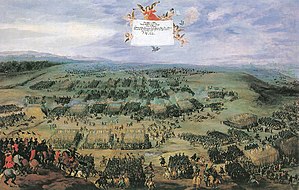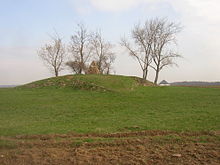Battle of White Mountain
Battle of the White Mountain
Part of: Bohemian-Palatinate War, Thirty Years' War

The Battle of White Mountain, painting by Pieter Snayers
Bohemian-Palatinate War (1618-1623)
Pilsen - Vražda - Sablat - White Mountain - Mingolsheim - Wimpfen - Höchst - Fleurus - Stadtlohn
The Battle of White Mountain (Czech: Bitva na Bílé hoře) near Prague on 8 November 1620 was the first major military conflict of the Thirty Years' War. In the course of it, the troops of the Bohemian estates under their king Frederick V of the Palatinate and his commander Christian I of Anhalt were defeated by the imperial and Bavarian troops of the Catholic League under the command of Buquoy and Tilly. After his defeat, Frederick V, the so-called Winter King, was forced to flee Bohemia. Emperor Ferdinand II was able to assert his claim to the crown of Bohemia.
Legend
Considering the strategically advantageous position of the Bohemian army occupying the ridge, it seems a remarkable achievement that the imperial troops nevertheless managed to achieve victory. Tilly, as commander of the Bavarian-Ligist troops supporting the imperial troops, is said to have been convinced of the impregnability of the White Mountain as late as the morning of November 8.According to legend, the Carmelite Dominicus a Jesu Maria entered the imperial army camp carrying an image of the Holy Family from the previously looted and burned Strakonice Castle, where Mary and Joseph had their eyes gouged out by Protestants. The desecrated image and his words about the need to avenge this sacrilege allegedly enraged the Catholic troops to such an extent that they stormed the mountain within a very short time with the battle cry "Santa Maria! The Bohemian army is said to have been completely taken by surprise by this unexpected attack, so that it fell into disorder and fled. On May 8, 1622, the effigy that had sparked the victory at White Mountain was carried to the Church of the Discalced Carmelites in Rome and placed on the high altar. The church, which until then had borne the patrocinium of St. Paul the Apostle, was thereupon named Santa Maria della Vittoria (Saint Mary of Victory). However, the original image of the Madonna was destroyed in a fire in 1833.
Frederick V fled into exile, and as he was able to maintain his rule as King of Bohemia for little more than a year, he was given the derisive name of "Winter King".
Course of the battle
Around noon on November 8, 1620, the right wing of the imperial troops started moving towards the Protestant Bohemian army. Subsequently, the Spanish cavalry and Walloon infantry also attacked the left wing of the Bohemian army. Already at this time, larger parts of the Bohemian army began to flee, but smaller parts fought doggedly against the uphill marching soldiers of the Imperial League troops, and the Bohemian soldiers under the command of Christian II of Anhalt (son of the commander-in-chief Christian of Anhalt) managed to repel the Spanish cavalry and, as a result, to break up a Walloon unit. Tilly, as commander of the Bavarian League troops, then ordered the Italian and Polish cavalry to charge, and they were subsequently able to blow up the order of the enemy Hungarian Bohemian cavalry and drive them into the Vltava, where many drowned.Now, taking advantage of the numerical superiority, the entire Catholic army began to move and fought the remaining soldiers of the Bohemian army in hand-to-hand combat. During this phase of the battle, the young Lieutenant-Governor Gottfried Heinrich zu Pappenheim, who was fighting on the imperial side, was also seriously wounded. Meanwhile, more and more of the Bohemian-Anhalt soldiers fled in the direction of Prague, where they slowly became aware of the impending defeat. King Frederick, who only the day before had ridden down the lines and exhorted the soldiers not to abandon either his or the Bohemian cause, had hurried back to Prague during the battle to beg the Bohemian estates for money for his troops and to receive the envoy of the English king. From him he hoped to receive the long-awaited news of the support of his father-in-law, James I. However, by the time Frederick was about to ride out of the city to rejoin the troops on the battlefield at noon on 8 November, it was already too late. At the city gate he met fleeing soldiers of his army and his chancellor Christian von Anhalt, who informed him of the disaster. Frederick, fearing extradition to the Bavarian duke, went into hiding in Prague's Old Town and escaped the next day in the direction of Breslau.

Contemporary representation

Monument from 1920 on the summit, in the background the hunting lodge Stern, which today houses an exhibition about the battle
Questions and Answers
Q: What was the Battle of White Mountain?
A: The Battle of White Mountain was the first battle of the Thirty Years War in which Duke Maximilian I of Bavaria defeated the forces of Frederick V, Elector of Palantine, King of Bohemia and Moravia.
Q: What was the cause of the battle?
A: The cause of the battle was a revolt by a group of Czech lords who threw two governors and a secretary out of the windows of Prague Castle in an incident known as the Defenestration of Prague. They built up an army of 30,000 to make an independent Protestant country.
Q: Who won the battle?
A: Duke Maximilian I of Bavaria won the Battle of White Mountain against the Czechs who had rebelled and built an army of 30,000 to create an independent Protestant country.
Q: How long did the battle last?
A: The battle lasted less than one hour before the Imperial army, well trained and led by Duke Maximilian I, defeated the Czechs.
Q: What happened after the battle?
A: Emperor Ferdinand II replaced Frederick as King of Bohemia and began a campaign of retribution against those who opposed him, killing many and giving others a choice of converting to Catholicism or leaving the country.
Q: Where is White Mountain located?
A: White Mountain is now located in the city of Prague, where there is an open space and monument to commemorate the battle.
Q: When did the Battle of White Mountain take place?
A: The Battle of White Mountain took place in 1620, marking the beginning of the Thirty Years War.
Search within the encyclopedia